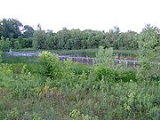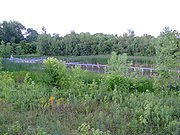
Olentangy River Wetland Research Park
Encyclopedia
The Wilma H. Schiermeier Olentangy River Wetland Research Park is an experimental wetland
complex located adjacent to the campus of The Ohio State University
in Columbus, Ohio
, USA. Begun in 1992, the park has developed into a multitude of different habitats and setups which are used by OSU faculty and students for research. Additionally, the general public is welcome to enjoy independent tours of the area during daylight hours. Guided tours are also available upon request. The research park creation and development has been led by Professor William J. Mitsch
, who received the 2004 Stockholm Water Prize
, partially because of his development of this research park.
 The site is located on a 20 hectares (49.4 acre) parcel immediately north of the Chemical Abstracts Service
The site is located on a 20 hectares (49.4 acre) parcel immediately north of the Chemical Abstracts Service
campus along the banks of the Olentangy River
. The first stage of the complex was completed in 1994 when two 1 ha (2.5 acre) kidney shaped marsh
es were built. Water in these areas is continuously pumped in from the river providing a consistent water level thought the year. Experimental Wetland 1 (west) was planted with wetland plants native to the area, while Experimental Wetland 2 (east) was left unplanted. This experiment into how wetlands develop is monitored every year and the differences noted. Boardwalks were constructed in the following years (1995 & 1996) to allow access to the wetland without disturbing the sediment. These boardwalks are normally closed to the public except during guided tours to prevent disturbance to the ongoing experiments.
In 1999, a 3 ha (7.4 acre) Billabong
was constructed to the southeast of the two experimental wetlands as part of the second phase of the park. This area replicates the habitat that might be found at an oxbow lake
. Water is gravity fed into the system from the Olentangy River only during times of high flow. Visitors are sometimes surprised to see the area almost totally devoid of water. However, this is completely normal, particularly during the summer months. A Mesocosm Compound for smaller scale research was built at the same time as the Billabong.
A 5 ha (12.4 acre) bottomland
hardwood forest on the site was restored in 1999-2000 when 4 breeches in an artificial levee were created to allow the river to flood the forest again. Studies have suggested that it is a more productive forest now. In addition, the invasive
Eurasian honeysuckle
(Lonicera mackii) is occasionally harvested in this forest to allow a more diverse understory to develop.
The third phase culminated in the construction of the Heffner Wetland Research and Education Building in 2003. Along with the building, three small wetlands were built. A stormwater wetland collects precipitation that falls on the roof of the building and allows it to be filtered. A pond that was dug deep enough to reach the water table provides a continuous supply of water to the adjacent swale
. To the west of the building is a small decorative wetland and an emerging red maple swamp.
In June 2008, the Olentangy River Wetland Research Park was formally designated as the USA's 24th Ramsar
Wetland of International Importance.
This is one of the first created wetland sites so designated in the world and was done so in recognition of the diverse flora and fauna at the site, the extensive wetland research that has taken place there, and the significant ecotourism at this urban wetland where 150 tours per year are given to thousands of visitors, educating them on the functions and values of wetlands.
Wetland
A wetland is an area of land whose soil is saturated with water either permanently or seasonally. Wetlands are categorised by their characteristic vegetation, which is adapted to these unique soil conditions....
complex located adjacent to the campus of The Ohio State University
Ohio State University
The Ohio State University, commonly referred to as Ohio State, is a public research university located in Columbus, Ohio. It was originally founded in 1870 as a land-grant university and is currently the third largest university campus in the United States...
in Columbus, Ohio
Columbus, Ohio
Columbus is the capital of and the largest city in the U.S. state of Ohio. The broader metropolitan area encompasses several counties and is the third largest in Ohio behind those of Cleveland and Cincinnati. Columbus is the third largest city in the American Midwest, and the fifteenth largest city...
, USA. Begun in 1992, the park has developed into a multitude of different habitats and setups which are used by OSU faculty and students for research. Additionally, the general public is welcome to enjoy independent tours of the area during daylight hours. Guided tours are also available upon request. The research park creation and development has been led by Professor William J. Mitsch
William J. Mitsch
William Mitsch, born March 29, 1947 in Wheeling, West Virginia USA, is an ecosystem ecologist and ecological engineer who was co-laureate of the 2004 Stockholm Water Prize in August 2004 as a result of a career in wetland ecology and restoration, ecological engineering, and ecological...
, who received the 2004 Stockholm Water Prize
Stockholm Water Prize
Presented annually since 1991, the Stockholm Water Prize is a prestigious award that recognises outstanding achievements in water related activities...
, partially because of his development of this research park.
Background

Chemical Abstracts Service
Chemical Abstracts is a periodical index that provides summaries and indexes of disclosures in recently published scientific documents. Approximately 8,000 journals, technical reports, dissertations, conference proceedings, and new books, in any of 50 languages, are monitored yearly, as are patent...
campus along the banks of the Olentangy River
Olentangy River
The Olentangy River is a tributary of the Scioto River in Ohio.It was originally called keenhongsheconsepung, a Delaware word literally translated as "stone for your knife stream", based on the shale found along its shores. Early settlers to the region translated this into "Whetstone River"...
. The first stage of the complex was completed in 1994 when two 1 ha (2.5 acre) kidney shaped marsh
Marsh
In geography, a marsh, or morass, is a type of wetland that is subject to frequent or continuous flood. Typically the water is shallow and features grasses, rushes, reeds, typhas, sedges, other herbaceous plants, and moss....
es were built. Water in these areas is continuously pumped in from the river providing a consistent water level thought the year. Experimental Wetland 1 (west) was planted with wetland plants native to the area, while Experimental Wetland 2 (east) was left unplanted. This experiment into how wetlands develop is monitored every year and the differences noted. Boardwalks were constructed in the following years (1995 & 1996) to allow access to the wetland without disturbing the sediment. These boardwalks are normally closed to the public except during guided tours to prevent disturbance to the ongoing experiments.
In 1999, a 3 ha (7.4 acre) Billabong
Billabong
Billabong is an Australian English word meaning a small lake, specifically an oxbow lake, a section of still water adjacent to a river, cut off by a change in the watercourse. Billabongs are usually formed when the path of a creek or river changes, leaving the former branch with a dead end...
was constructed to the southeast of the two experimental wetlands as part of the second phase of the park. This area replicates the habitat that might be found at an oxbow lake
Oxbow lake
An oxbow lake is a U-shaped body of water formed when a wide meander from the main stem of a river is cut off to create a lake. This landform is called an oxbow lake for the distinctive curved shape, named after part of a yoke for oxen. In Australia, an oxbow lake is called a billabong, derived...
. Water is gravity fed into the system from the Olentangy River only during times of high flow. Visitors are sometimes surprised to see the area almost totally devoid of water. However, this is completely normal, particularly during the summer months. A Mesocosm Compound for smaller scale research was built at the same time as the Billabong.
A 5 ha (12.4 acre) bottomland
Upland and lowland (freshwater ecology)
In studies of the ecology of freshwater rivers, habitats are classified as upland and lowland.-Definitions:Upland habitats are cold, clear, rocky, fast flowing rivers in mountainous areas; lowland habitats are warm, slow flowing rivers found in relatively flat lowland areas, with water that is...
hardwood forest on the site was restored in 1999-2000 when 4 breeches in an artificial levee were created to allow the river to flood the forest again. Studies have suggested that it is a more productive forest now. In addition, the invasive
Invasive species
"Invasive species", or invasive exotics, is a nomenclature term and categorization phrase used for flora and fauna, and for specific restoration-preservation processes in native habitats, with several definitions....
Eurasian honeysuckle
Honeysuckle
Honeysuckles are arching shrubs or twining vines in the family Caprifoliaceae, native to the Northern Hemisphere. There are about 180 species of honeysuckle, 100 of which occur in China; Europe, India and North America have only about 20 native species each...
(Lonicera mackii) is occasionally harvested in this forest to allow a more diverse understory to develop.
The third phase culminated in the construction of the Heffner Wetland Research and Education Building in 2003. Along with the building, three small wetlands were built. A stormwater wetland collects precipitation that falls on the roof of the building and allows it to be filtered. A pond that was dug deep enough to reach the water table provides a continuous supply of water to the adjacent swale
Swale (geographical feature)
A swale is a low tract of land, especially one that is moist or marshy. The term can refer to a natural landscape feature or a human-created one...
. To the west of the building is a small decorative wetland and an emerging red maple swamp.
In June 2008, the Olentangy River Wetland Research Park was formally designated as the USA's 24th Ramsar
Ramsar Convention
The Ramsar Convention is an international treaty for the conservation and sustainable utilization of wetlands, i.e., to stem the progressive encroachment on and loss of wetlands now and in the future, recognizing the fundamental ecological functions of wetlands and their economic, cultural,...
Wetland of International Importance.
This is one of the first created wetland sites so designated in the world and was done so in recognition of the diverse flora and fauna at the site, the extensive wetland research that has taken place there, and the significant ecotourism at this urban wetland where 150 tours per year are given to thousands of visitors, educating them on the functions and values of wetlands.

